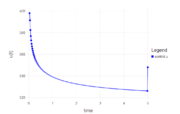Difference between revisions of "Batch reactor"
FelixMueller (Talk | contribs) |
FelixMueller (Talk | contribs) |
||
| Line 43: | Line 43: | ||
[pictures coming] | [pictures coming] | ||
| − | + | <gallery caption="Reference solution plots" widths="180px" heights="140px" perrow="2"> | |
| − | Image: | + | Image:batch_reactor_state_plot.png| Optimal states x_1(t) and x_2(t). |
| − | + | Image:batch_reactor_control_plot.png| Optimal control u(t). | |
| − | Image: | + | |
| − | + | ||
</gallery> | </gallery> | ||
| − | + | ||
== Source Code == | == Source Code == | ||
Revision as of 19:32, 12 January 2016
| Batch reactor | |
|---|---|
| State dimension: | 1 |
| Differential states: | 2 |
| Continuous control functions: | 1 |
| Discrete control functions: | 0 |
| Interior point equalities: | 2 |
This batch reactor problem describes the consecutive reaction of some substance A via substance B into a desired product C.
The system is interacted with via the control function  which stands for the temperature.
The goal is to produce as much of substance B (which can then be converted into product C) as possible within the time limit.
which stands for the temperature.
The goal is to produce as much of substance B (which can then be converted into product C) as possible within the time limit.
Mathematical formulation
The optimal control problem is given by
![\begin{array}{llcl}
\displaystyle \max_{x, u} & x_2(t_f) \\[1.5ex]
\mbox{s.t.} & \dot{x}_1(t) & = & -k_1 x_1^2, \\
& \dot{x}_2(t) & = & k_1 x_1^2 - k_2 x_2, \\
& k_1 & = & 4000 \; e^{(-2500/T)}, \\
& k_2 & = & 620000 \; e^{(-5000/T)}, \\[1.5ex]
& x(0) &=& (1, 0)^T, \\
& T(t) &\in& [298, 398].
\end{array}](https://mintoc.de/images/math/6/b/6/6b6db83068dec5bae5340524853664fb.png)
 and
and  stand for the concentrations of A and B at timepoint
stand for the concentrations of A and B at timepoint  respectively. The control function
respectively. The control function  represents the temperature.
represents the temperature.
Parameters
The starting time and end time are given by ![[t_0, t_f] = [0, 1]](https://mintoc.de/images/math/9/0/d/90d354576ba03d7a9fb1d63ba2ecc7cc.png) .
.
Reference Solutions
This solution was computed using JuMP with a collocation method and 300 discretization points. The differential equations were solved using the explicit Euler Method. The source code can be found at Batch reactor (JuMP).
The optimal objective value of the problem is  .
.
[pictures coming]
- Reference solution plots
- Batch reactor state plot.png
Optimal states x_1(t) and x_2(t).
Source Code
Model descriptions are available in
References
The problem can be found in the Tomlab PROPT guide or in the Dynopt guide.
